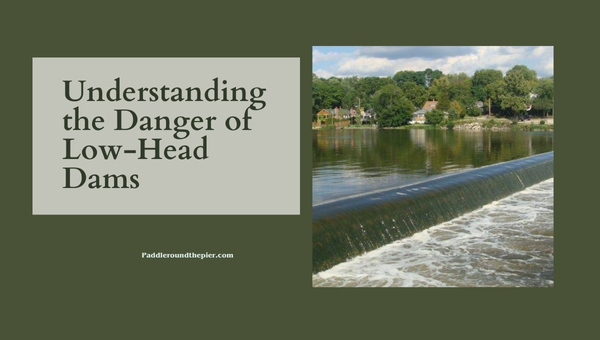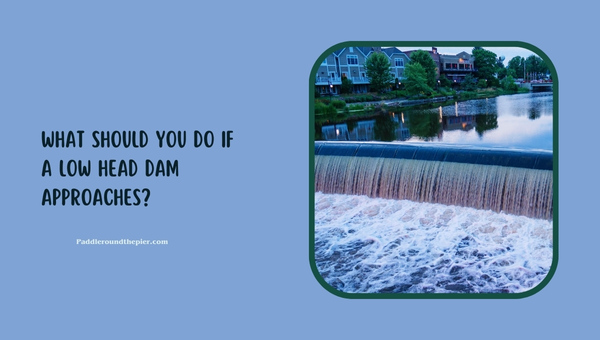Low Head Dam Safety: Key Actions When One is Approaching
As recreational boaters, anglers, or paddle boarders, we routinely engage with nature's convoluting channels. While the experience can be euphoric, it sometimes introduces us to threatening yet often overlooked river structures: low-head dams. Recognizing and understanding low-head dam safety is a crucial aspect of our river excursions.
Low-head dams might seem harmless, but these "Drowning Machines," as they're often referred to colloquially, hide fatal undertow currents. Many are deceived by their modest height – ranging from just a few feet to several feet tall – and picturesque water curtains overflowing the dam's face. It's the unexpected hazards that coerce us to become vigilant and informed about 'low head dam safety'.
Here's What You Can Expect from This Piece
- Identification features of low-head dams
- Understanding why these dams pose such danger
- Discover essential safety precautions for approaching a low-head dam.
- Survival tricks if you find yourself trapped in the perilous churn of a low-head dam
Understanding the Danger of Low-Head Dams

What is a Low Head Dam?
You might be wondering, "What exactly is a low-head dam?" Allow me to enlighten you. In the simplest terms, a low-head dam is a structure that spans a river or stream and creates an elevation difference in the water level. These dams are used for irrigation, water supply, and other purposes. But don't let their innocuous uses deceive you; approaching a low-head dam carries considerable risk.
Here are some key features to help paint a picture:
- Width: These dams can span the entire width of the river or stream they cross.
- Height: They're often less than ten feet high—thus their name—but some can tower up to twenty feet.
- Reverse Currents: As water flows over these barriers, it creates extremely strong backflows directly downstream from the dam.
Why are Low Head Dams Dangerous?
If this doesn't seem all that terrifying on its surface, consider this: Low-head dams have earned themselves nicknames like "drowning machines" due to their deceptive dangers. Here's why:
- Strong Eddy Currents: The rushing water over these short dams forms potent circular currents below the surface, which can trap people and objects.
- Difficulty Spotting These dams often aren't visible until one's virtually on top of them.
- Deceptive Tranquility: Viewed from upstream, these dams can appear as innocuous ripples in otherwise calm waters, drawing boaters onto them without warning.
While one might dream of navigating through these river hazards with adrenaline-fueled expertise like something out of an adventurous movie scene, reality paints another picture altogether. The tragedy lies in this contrast—treating low-head dam water safety lightly could land you in life-threatening trouble really fast!
Also Read: Verde River Kayaking Destination: Why Is It Unique?
Importance of Awareness about Low Head Dam Safety
Engaging in water activities in river areas can be an exhilarating experience, but let's not underestimate the risks associated with specifically low-head dams. Being informed and taking necessary precautions is indeed fundamental to ensure you have a fun—and safe—experience.
Identifying a Low-Head Dam
First things first, what does it mean for me to talk about a low-head dam? And how can I spot one? Undermining this fact could make it harder for me to advocate for 'low head dam safety.' Mastering how to recognize them visually and understanding their characteristics are key points in preparing an individual for approaching a low-head dam. Here are a few key points for better identification:
- Visual Recognition - They usually span the width of the river or stream, forming a neat barricade.
- Sound Indicators - As you approach one, the murmur or roar of water rushing over the simple structure makes itself audible.
- Look out For Warning Signs - Some well-marked dams will have signs highlighting their presence.
Remember, looks can be deceiving! In calm weather or at particular angles, these might seem like harmless river features. However, understanding their true nature emphasizes that they are significant contributors to the 'dangers of low-head dams.'
Safety Precautions Around Low-Head Dams
Now that we know how to identify one when we see it, let's discuss some important steps revolving around 'low head dam water safety,' which should be kept in mind while indulging near such places:
- Maintain Safe Distance: Always stay at least several hundred feet away from both the upstream and downstream sides of the dam.
- Never Swim or Boat near One: Strong undercurrents and turbulent waters make it incredibly dangerous to swim or boat near these structures, regardless of how calm they may appear on top.
- Use Life Jackets: If you somehow find yourself in waters close to the dam, a well-fitted life jacket can be your best shot at survival.
- Identify Exit Routes: Make it a point to know where the nearest shore is and how quickly you can get there. In case of a mishap, this information could save lives.
What Should You Do If A Low Head Dam Approaches?

As we all have heard, prevention is always better than cure. Believe it or not, this axiom holds true even when you're talking about the menacing low-head dam safety. So, what should you do if a low-head dam approaches?
Prior Preparation
Being prepared for any possibility is the first line of defense for ensuring your safety around these river hazards and navigating low-head dams. Here's what you can do:
- Staying in Shape: Knowing how to swim well is a necessary skill set. It doesn't hurt to also have someone in your group who knows CPR and basic first aid principles.
- Equipping Yourself Properly: Always wear a life jacket when approaching a low-head dam. Throw ropes and other water emergency equipment should be within easy reach.
- Getting Information: Learn about the body of water you plan to navigate or be around. Be aware of hidden dangers, such as low-head dams that can present significant risks but may not always be clearly visible.
With that said, being prepared doesn't end with having knowledge and equipment on deck; it also includes mentally preparing for the worst-case scenarios involving the dangers of low-head dams.
Immediate Response Actions
Oftentimes, direct interaction with a Low Head Dam happens without warning—accidentally coming too close due to strong currents or an unexpected fall from the riverbank—this is where understanding immediate response actions comes into play:
- Avoid Panicking Stay centered and avoid succumbing to panic.
- Call Out For Help: Immediately alert nearby individuals by yelling out or using a whistle if available.
- Swim To The Shore: If possible, make an aggressive move away from the dam toward the shore.
- Work With The Flow: Swim on your back with feet pointed downstream if caught in rapid current flow towards the dam until you clear its vicinity.
Having explained some tips on low-head dam water safety, it's significant to stress that the best plan when encountering a low-head dam is to avoid interaction altogether. But in those unfortunate instances where it is unavoidable, being priorly prepared and knowing immediate response actions will give you a better chance at survival.
Also Read: Unveiling What Paddle Boards are Made Of: An Expose
Survival Tips & Techniques in case of an emergency at Low Head Dam
Emergencies can strike when least expected, especially when one is around a deceivingly serene but incredibly dangerous structure like a low-head dam. The key to surviving in such predicaments often hinges on being knowledgeable about the hazards and prepared to tackle them effectively. Bearing this crucial aspect of 'low-head dam safety' in mind, let's discuss some invaluable strategies for survivorship should you find yourself trapped at a low-head dam.
Strategies for Survivorship When Trapped at a Low-Head Dam
Surviving the powerful currents and dangerous conditions around these dams is no small feat. However, with the proper strategies and trained techniques, it is possible to increase your chances of survival. Below are some proven strategies that I highly recommend:
- Develop Strong Swimming Skills: It might seem rudimentary, yet having strong swimming skills can be a real lifesaver in these situations. Knowing different strokes and how to use them optimally could make all the difference.
- Don't Fight Against Currents: While it might be our instinct to struggle against the current if we’re caught up in it, this is often a detrimental move. Instead, try conserving your energy by floating as much as you can until you're out of the turbulent zone.
- Reach for Rescue Devices: If rescue devices like ropes or floatation aids are thrown towards you, do your utmost best to reach out and grab hold of them.
- Use Safety Equipment: Always have life jackets or personal floatation devices (PFDs) on while approaching a low-head dam. These tools are designed specifically to boost buoyancy and give you that extra support needed during emergencies.
- Adopt Self-rescue Techniques: There are several self-rescue strategies, which include ‘defensive swimming’ where one floats on their back with feet downstream, allowing better visibility ahead along with protecting oneself from obstructions.
- Signal for Help: If you’re caught in the 'drowning machine' effect of a low-head dam, try signaling for help using universal distress signals that can be easily spotted by onlookers or rescue teams.
These points aren't just about learning how to navigate low-head dams; they're about understanding what to do in critical situations to increase chances of survival. They're part of the larger narrative around 'river hazards and low head dams.' It's integral that we empower ourselves with this knowledge, as it can literally make the difference between life and death when faced with the dangers of low-head dams.
FAQs
Why is it so hard to escape from the recirculating currents of a Low-Head Dam?
The recirculating current or "drowning machine" of a low-head dam is incredibly powerful and can trap individuals underneath the surface, making escape extremely difficult without expert intervention.
What can you do if you see someone else stuck at a Low-head dam?
It's important not to attempt a direct rescue yourself due to the same risks. Call 911 immediately and try to throw them a lifebuoy or something they can cling onto until help arrives.
How effective are life jackets around low-head dams?
Although life jackets increase buoyancy, they aren't foolproof around low-head dams. The forceful waters can trap even those wearing life jackets, but wearing them is still strongly advised for safety purposes
Are there signs posted indicating the presence of all types of dams, including 'Low-head'?
Not always. While some areas may have warning signs, others might not be clearly marked. Hence, personal caution while navigating waters with potential low-head dams is crucial.
Conclusion
Navigating the dangers of low-head dams can be a daunting task, but it's not impossible. With awareness and appropriate preparation, potential disasters can be mitigated. Always remember that understanding the nature and location of a low-head dam allows for appropriate safety precautions. Being equipped with knowledge on how to swim and use rescue equipment could literally save lives, making it crucial in ensuring your safety around low-head dams.
Key Takeaway Points
- Recognize the distinctive characteristics of a low-head dam.
- Dangers of low-head dams often involve strong undercurrents leading to potential drownings.
- Prior preparation is key to ensuring safety around these areas.
- If trapped, knowing survival strategies can dramatically increase the chances of surviving such an event.
